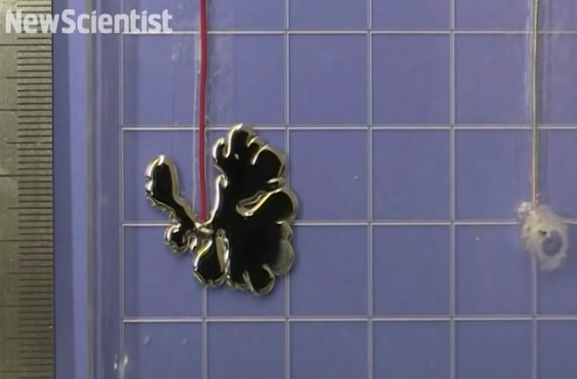
Many fans of the Terminator films will remember the T-1000, the shape-shifting robot that appeared in the the second film of the franchise.
A self-propelled liquid metal motor has been developed, bringing us much closer to real T-1000 robots in the future.

BYPASS THE CENSORS
Sign up to get unfiltered news delivered straight to your inbox.
You can unsubscribe any time. By subscribing you agree to our Terms of Use
Latest Video
A group of researchers from the Tsinghua University in Beijing, China, have invented the first liquid metal robot – it can change shapes and power itself.
The New Scientist reports:
Hasta la vista, baby. A real-life T-1000, the shape-shifting liquid-metal robot from Terminator 2, is a step closer, thanks to a self-powered liquid metal motor.
The device is surprisingly simple: just a drop of metal alloy made mostly of gallium – which is liquid at just under 30 °C – with some indium and tin mixed in. When placed in a solution of sodium hydroxide, or even brine, and kept in contact with a flake of aluminium for “fuel”, it moves around for about an hour. It can travel in a straight line, run around the outside of a circular dish, or squeeze through complex shapes.
“The soft machine looks rather intelligent and [can] deform itself according to the space it voyages in, just like [the] Terminator does from the science-fiction film,” says Jing Liu from Tsinghua University in Beijing, China. “These unusual behaviours perfectly resemble the living organisms in nature,” he says, adding that they raise questions about the definition of life.
When they first saw the drop move, Liu and colleagues weren’t sure how it was able to do so. Experiments revealed two mechanisms at play. Some of the thrust stems from a charge imbalance across the drop, which in turn creates a pressure differential between the front and the back that pushes it forward. The aluminium also reacts with the sodium hydroxide, releasing hydrogen bubbles which drive the drop even faster.
Other researchers have shown that a stationary gallium drop can act as a pump when in an electric field. Liu followed up this idea and showed that if their self-powered motor is held still, it too becomes a pump, shifting about 50 millilitres of water every second. “It’s the first ever self-powered pump,” he says. The team says that could have immediate applications for moving liquid through a cooling device without the need for an external power source.
The work is part of a long-term effort to create intelligent robots that are non-rigid and so can be reshaped on the fly, a bit like the fictional T-1000. Liu says a robot based on their device could soon be used to monitor the environment or deliver materials within pipes and even blood vessels.
Last year both Liu’s group and one led by Michael Dickey at North Carolina State University in Raleigh showed that the gallium alloy forms complex shapes in response to an applied electrical current. When the current is turned off, it returns to the simple drop shape. Liu says these two methods could be used together to change the drop’s velocity, or to coordinate a swarm of independent drops.
Taro Toyota of the University of Tokyo says the invention could help convert chemical energy to mechanical energy in a future liquid robot. “Such liquid robots will be a seed of artificial life seen in some movies,” he says. “I would raise Flubber instead of Terminator 2.”
Journal reference: Advanced Materials, DOI: 10.1002/adma.201405438



